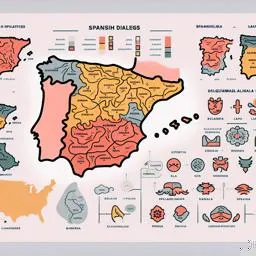Spanish, or español, is a vibrant and dynamic language spoken by over 460 million native speakers worldwide. As with any widely spoken language, Spanish has evolved into various dialects and regional variations, each with its unique characteristics and nuances. Understanding these differences can enrich your language learning experience and enhance your ability to communicate effectively across different Spanish-speaking regions.
1. The Global Reach of Spanish
Spanish is the official language of 21 countries, spanning continents from Europe to the Americas, and even parts of Africa. This widespread use has naturally led to the development of distinct dialects. While the core structure of the language remains consistent, pronunciation, vocabulary, and even grammar can vary significantly from one region to another.
2. Major Spanish Dialects
2.1. Castilian Spanish
Castilian Spanish, or castellano, is often considered the standard form of the language. Originating from the Castile region in Spain, it is the basis for the Spanish taught in most educational institutions worldwide. Key features include the use of the vosotros form for the second person plural and the distinctive pronunciation of the "c" and "z" as a "th" sound in English.
2.2. Andalusian Spanish
Spoken in the southern region of Andalusia, Andalusian Spanish is known for its rapid speech and tendency to drop consonants, particularly the "s" at the end of words. This dialect has significantly influenced Latin American Spanish, especially in the Caribbean.
2.3. Latin American Spanish
Latin American Spanish encompasses a wide range of dialects spoken across Central and South America. While there are many regional variations, a few common traits include the use of "ustedes" instead of "vosotros" for the second person plural and a tendency to simplify certain verb conjugations.
2.3.1. Mexican Spanish
Mexican Spanish is characterized by its clear pronunciation and the use of indigenous words, such as chocolate and tomate. It is one of the most widely spoken dialects due to Mexico's large population and cultural influence.
2.3.2. Caribbean Spanish
Caribbean Spanish, spoken in countries like Cuba, Puerto Rico, and the Dominican Republic, is known for its rhythmic intonation and the frequent omission of consonants, particularly "s" and "d". This dialect also incorporates many words from African and indigenous languages.
2.3.3. Rioplatense Spanish
Found in Argentina and Uruguay, Rioplatense Spanish is famous for its use of voseo, where "vos" replaces "tú" for the second person singular. The dialect also features a distinctive pronunciation of the "ll" and "y" sounds as "zh" or "sh".
3. Influences on Spanish Dialects
The evolution of Spanish dialects has been shaped by historical, cultural, and geographical factors. The influence of indigenous languages in Latin America, for instance, has introduced unique vocabulary and expressions into the local dialects. Similarly, the proximity to other languages, such as Portuguese in the case of Rioplatense Spanish, has led to shared linguistic features.
4. Understanding Regional Variations
While the diversity of Spanish dialects may seem daunting, it is important to remember that mutual intelligibility is generally high among Spanish speakers. Exposure to different dialects through media, travel, and conversation can significantly improve comprehension and adaptability.
5. Practical Tips for Navigating Dialects
- Listen Actively: Engage with a variety of Spanish media, including music, films, and podcasts, to familiarize yourself with different accents and vocabulary.
- Practice Flexibility: Be open to learning and using regional vocabulary and expressions. This will not only improve your language skills but also help you connect with native speakers on a deeper level.
- Ask Questions: If you encounter unfamiliar words or expressions, don't hesitate to ask for clarification. Most native speakers are happy to share insights about their dialect.
6. Conclusion
The rich tapestry of Spanish dialects and regional variations reflects the language's global reach and cultural diversity. By embracing these differences, language learners can gain a more comprehensive understanding of Spanish and enhance their ability to communicate across diverse Spanish-speaking communities. Whether you're planning to travel, work, or simply explore the Spanish-speaking world, an awareness of these dialectical nuances will undoubtedly enrich your experience.
As you continue your journey in learning Spanish, remember that each dialect offers a unique perspective and a deeper connection to the culture and people who speak it. Embrace the diversity of the Spanish language, and you'll find that it opens doors to a world of new experiences and friendships.








